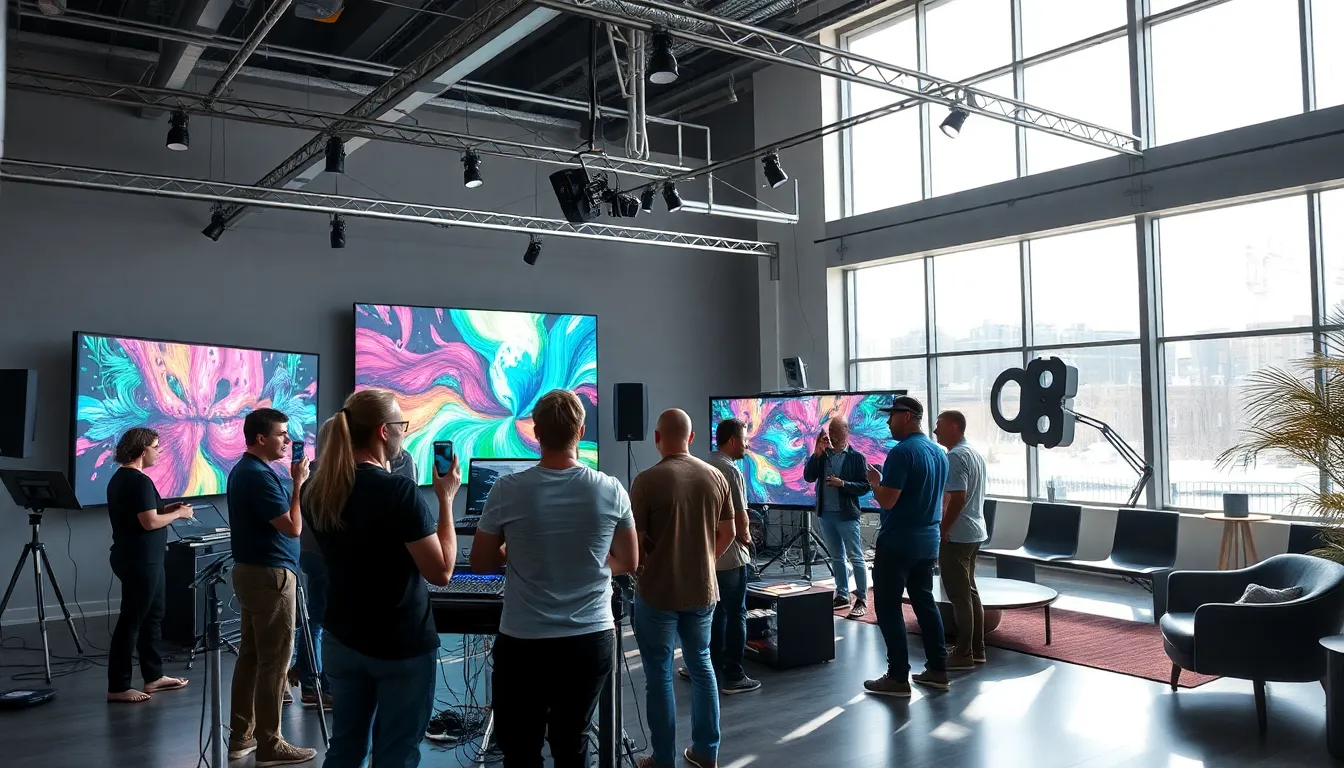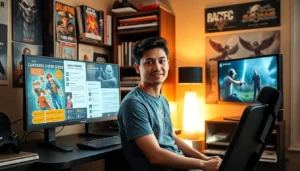In today’s fast-paced world, the intersection of art and technology is not just a conversation starter, it’s a revolution that artists can hardly ignore. Who knew that your AV system could be as vital to creativity as the paintbrush or the camera? As innovations unfold, artists are no longer limited to traditional mediums. Instead, they are immersing themselves in a digital playground where imagination meets state-of-the-art technology. From virtual reality to the latest audio designs, the art world is buzzing with new opportunities. Buckle up, as we jump into the multifaceted realm of arts audio/video technology and communications.
Table of Contents
ToggleOverview of Audio/Video Technology in the Arts

Historical Development
Audio and video technology have come a long way since the invention of the phonograph and the motion picture camera. In the early days, art was something tangible, something that could be touched and felt. But, as technology advanced, so did the methods artists used to convey their messages. The 1960s saw artists experiment with film and electronic media, paving the way for today’s digital landscape. With the rise of computers in the 1980s, digital art became a reality, allowing for an explosion of creativity that was previously unimaginable. Artists began using software to manipulate sound and images, effectively reshaping the landscape of artistic expression.
Current Trends and Innovations
Fast forward to today, and the arts community is witnessing an unprecedented surge in innovations. Interactive installations, where spectators can influence the art around them through motion sensors, have become commonplace. Streaming platforms now allow artists to reach global audiences in real-time. Also, accessibility to high-quality production tools means that aspiring creators can now produce breathtaking content from their homes. Technologies like 3D printing and artificial intelligence are rapidly transforming arts practices, providing artists with tools that not only enhance creativity but also redefine what art can be.
Impact on Creative Expression
Enhanced Collaboration Among Artists
The convergence of audio/video technology has birthed a new era of collaboration among artists. Instead of working in isolation within their studios, creators are connected across the globe via digital platforms. Musicians can collaborate with visual artists, making multimedia presentations that transcend traditional boundaries. Apps and online communities allow artists to share ideas, receive feedback, and co-create like never before. This synergy not only enhances individual creativity but also enriches the art itself, leading to innovative interpretations and groundbreaking projects that have the potential to move audiences profoundly.
Virtual and Augmented Reality in Arts
Imagine stepping into a painting or experiencing a symphony that pulsates through your entire being. Virtual and augmented reality technologies make this a reality. Artists are now using VR to create immersive experiences that engulf viewers entirely, fostering a deeper emotional connection. Similarly, AR can put digital art over the top of existing landscapes, transforming streets into galleries. These technologies elevate the interaction between the artist and audience, stimulating multiple senses and opening the door for new artistic narratives.
The Role of Communications in Arts Technology
Effective Storytelling Through Modern Media
Effective storytelling is at the heart of art, and in today’s digital age, the mediums available to tell those stories are vast. Social media platforms allow artists to tell their stories with images, videos, and even live-streaming. This accessibility not only attracts a larger audience but also allows for an authentic connection. Artists can showcase their creative process, gather insights, and even involve their audience in the story. By fusing technology with storytelling, creators can bring their artistic visions to life in ways that are engaging and relatable.
Adapting to New Platforms and Audiences
The landscape of communication is ever-changing. Creators must be agile, adapting their messages to fit various platforms. Whether it’s a video for TikTok or a series of stills on Instagram, understanding the nuances of each platform ensures that the work reaches its intended audience. Also, different demographics consume content in distinct ways, making it crucial for artists to tailor their communications. This adaptability not only broadens their reach but also deepens their impact.
Challenges and Ethical Considerations
Intellectual Property Issues in Digital Arts
With advancements in technology come challenges, particularly in protecting intellectual property. In an age where sharing creative works online is as simple as a few clicks, artists risk having their work appropriated without credit. Copyright laws struggle to keep up with digital innovations, leaving artists vulnerable and uncertain. It’s paramount for creators to educate themselves about their rights and seek ways to protect their original content. In a collaborative environment, respecting one another’s work fosters a culture of trust and integrity.
Accessibility and Inclusivity in Tech-Driven Arts
As technology progresses, it is crucial to address accessibility. Not all artists have the same resources, and while some may have access to cutting-edge tools, others may not. This disparity can create a divide in artistic expression, making it essential for institutions and organizations to promote inclusivity. Ensuring that all artists, regardless of background, have opportunities to thrive in this tech-driven landscape is vital for a rich and diverse arts community.
Future Directions in Arts Audio/Video Technology
Emerging Technologies on the Horizon
The future of arts audio/video technology is teeming with possibilities. Advancements in artificial intelligence are facilitating the creation of hyper-realistic renderings and allowing for personalized art experiences. Besides, machine learning can analyze audience reactions, providing artists with data on what resonates. This insight drives creativity and refines the artist’s approach, leading to more intentional and purposeful work. Technological integration will empower artists like never before, transforming the landscape of art into a collaborative space between creator and consumer.
Sustainability in Arts Production
As the world increasingly focuses on sustainability, the arts cannot afford to lag behind. Future technology must emphasize eco-friendly practices to align with global sustainability goals. Artists are experimenting with biodegradable materials and digital formats that reduce waste. By adopting sustainable practices, artists not only contribute to environmental preservation but also make powerful statements about value and responsibility in their art.


